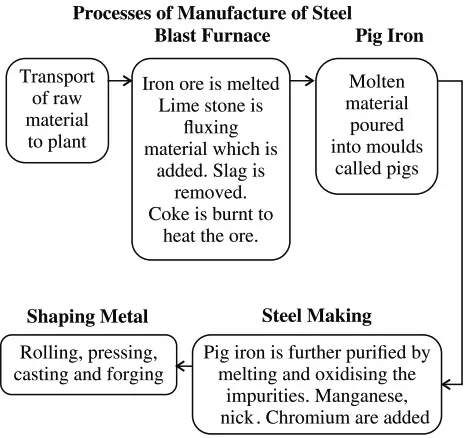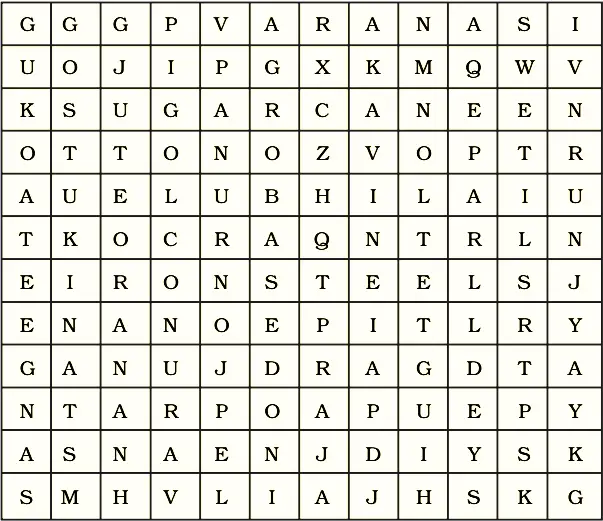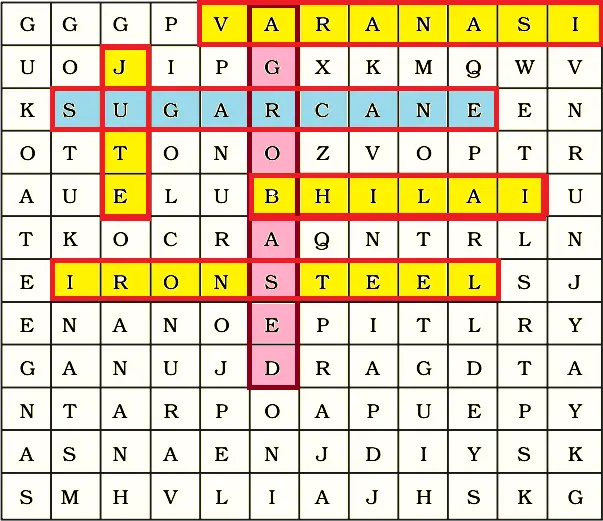NCERT Solutions for Class 10 Social Science Chapter 6: Manufacturing Industries - Ace your CBSE Exams!
Grasp agricultural concepts with ease! NCERT Solutions for Class 10 Social Science Chapter 6: Manufacturing Industries provides comprehensive explanations and answers to all exercise questions. Understand various manufacturing sectors and various types of industries in India. Boost your exam preparation and score high marks in CBSE Social Science!
NCERT Solutions
Intext Questions
Question.1. Classify the following into two groups on the basis of bulk and weight of raw material and finished goods.
(i) Oil
(ii) Knitting needles
(iii) Brassware
(iv) Fuse Wires
(v) Watches
(vi) Sewing Machines
(vii) Ship building
(viii) Electric Bulbs
(ix) Paint brushes
(x) Automobiles
Ans. Light industries : Knitting needles, fuse wire, watches, electric bulbs, paint brushes.
Heavy industries : oil, brassware, sewing machine, ship building, automobiles.
Question.2. Make a list of all such goods made of steel that you can think of.
Ans.
- Utensils.
- Cars.
- Water Bottles.
- Buildings.
- Bridges.
- Paper clip.
- Surgical equipment.
- Food can
Question.3. Collect information about products of steel plants in India.
Ans.
- Products used in the construction sector: metal roofing, steel beams, reinforcing steel and mounting brackets, steel safety barriers for roads, lighting and high voltage pylons, etc.
- Products used in the automobile sector: private cars, trucks, trains, cycles, railings, and railways.
Question.4. Have you read about the Kalinganagar controversy? Collect information from different sources and discuss.
Ans.
- When the Odisha police opened fire on a gathering of villagers On January 2, 2006, the village, near the Kalinganagar steel hub in Jajpur district, who had come to protest the construction of the boundary wall of a Tata Steel plant.
- Thirteen Adivasis and a policeman were killed, sending shock waves across Odisha.
- The land on which Adivasis were living for centuries was being taken away by the state with the promise of the benefits of development that would come along and transform their lives. They were also promised at least one job in a family.
- Factories came up, mining began, but the transformation in the lives of the people remained elusive; instead, what they began witnessing was destruction of the environment around them.
Question.5. A factory produces aluminium saucepans with plastic handles. It obtains aluminium from a smelter and a plastic component from another factory. All the manufactured saucepans are sent to a warehouse:
1. (a) Which raw material is likely to be most expensive to transport and why?
Ans. Aluminium is expensive because it is used in large quantities as compared to plastic handles.
(b) Which raw material is likely to be the cheapest to transport and why?
Ans. Plastic components are cheaper because they are used in small quantities.
2. Do you think the cost of transporting the finished products after packaging is likely to be cheaper or more expensive than the cost of transporting aluminium and plastic? Why?
Ans. The cost of transporting the finished products after packaging is cheaper because all the materials came from different places are combined to make one final product, so now the transportation cost is of one product only.
Question.6. Where would it be economically viable to set up the cement manufacturing units?
Ans. The ideal location for cement manufacturing units are:
- They should be near the sources of raw materials.
- Coal and electric power should be available.
- Some other raw materials like gypsum and clay should be nearly available.
Question.7. Find out where the plants are located in other states of India.
Ans. The cement industry in India is located in the following states :
- Jharkhand – Sindri, Japla, Jhikayani, Kalyanpur etc.
- Karnataka – Bagal kot, Bijapur, Gulbarga etc.
- Tamil Nadu – Tirunelveli, Rajamalayalam, Durg etc.
- Uttar Pradesh – Sonbhadra, Mirzapur, Rae Bareli etc.
- Madhya Pradesh – Katni, Satna, Damoh, Gwalior, Neemuch etc.
- Andhra Pradesh –Panayam, Machrela, Machilipatnam, Vijayawada etc.
- Rajasthan – Chittorgarh, Nimbaheda, Sawai Madhopur, Lakheri etc.
Question.8. His father explained that shoes, clothes, sugar etc. are manufactured by machines in large industries, some utensils are manufactured in small industries, while items like diyas are made by individual artisans in household industry. Do you have some ideas about these industries?
Ans. Shoes, clothes, sugar etc. are manufactured by machines in large industries because these products require different raw materials and number of other inputs. Therefore, it requires a large place for the processing of different materials. Utensils are manufactured in small industries because it requires less no. Of inputs and processing.
- Diyas require very less no. Of inputs and processing so, it can be made by individuals.
Question.9. Why did Mahatma Gandhi lay emphasis on spinning yarn and weaving khadi?
Ans. Mahatma Gandhi believed in the ideology of ‘Swadeshi’ , which implies to use everything that is made in India. During the colonial period, the British had discouraged the Indian textile industries and promoted the British made goods especially the textiles. This led to the closure of several Indian hand loom industries and this resulted in the huge loss for the weavers. Gandhi and other leaders in order to promote swadeshi goods encouraged the people to spin yarn and weave Khadi. The handspun khadi provides large scale employment to weavers in their homes as a cottage industry.
Question.10. Why is it important for our country to keep the mill sector loom age lower than power loom and handloom?
Ans. Keeping the mill sector loom age low helps the poor weavers to earn and face the competition with the mass products. The power loom and handloom will help to provide employment in the rural areas and reduce the migration of villagers to the cities.
Question.11. Why is it important for us to improve our weaving sector instead of exporting yarn in large quantities?
Ans. Because majority of the rural population in India apart from agriculture is involved in weaving cloth. Weaving is an important occupation of the rural people. It helps them to earn income to sustain their families especially at the time when crops fail.
Question.12. Why is the per capita consumption of steel so low in India?
Ans. Per capita consumption of steel in India are because of the following reasons:
- High costs and limited availability of coking coal
- Low productivity of labour
- Disrupted supply of electricity
- Poor infrastructure
Question.13. Find out where the plants are located in other states of India.
Ans. There are a total of 210 cement plants all over the India.
TEXTBOOK EXERCISE
I. Multiple choice questions.
Question.1. Which one of the following industries uses limestone as a raw material.
(A) Aluminium
(B) Cement
(C) Plastic
(D) Automobile
Ans. (B) Cement
Question.2. Which one of the following agencies markets steel for the public sector plants?
(A) HAIL
(B) SAIL
(C) TATA Steel
(D) MNCC
Ans. (B) SAIL
Question.3. Which one of the following industries uses bauxite as a raw material?
(A) Aluminium Smelting
(B) Cement
(C) Paper
(D) Steel
Ans. (A) Aluminium Smelting
Question.4. Which one of the following industries manufactures telephones, computer, etc.
(A) Steel
(B) Electronic
(C) Aluminium Smelting
(D) Information Technology
Ans. (B) Electronic
II. Answer the Following Briefly In not More than 30 Words.
Question.1. What is manufacturing?
Ans. Production of goods in large quantities after processing from raw materials to more valuable products is called manufacturing.
Question.2. Name any three physical factors for the location of the industry.
Ans. Following are the physical factors for the location of the industry:
- availability of raw materials
- closeness to market
- availability of power
Question.3. Name any three human factors for the location of an industry.
Ans. Following are the three human factors for the location of an industry:
- Labor
- Capital
- closeness to cities
Question.4. What are basic industries? Give an example.
Ans. Basic or key industries are those which supply their products as raw materials to manufacture other goods e.g., iron and steel and copper smelting, aluminum smelting.
Question.5. Name the important raw materials used in the manufacturing of cement?
Ans. Raw materials like limestone, silica and gypsum are used in the manufacturing of cement.
III. Write the Answers of The Following questions In 120 Words.
Question.1. How are integrated steel plants different from mini steel plants? What problems does the industry face? What recent developments have led to a rise in the production capacity?
Ans.
- Integrated Steel Plants are large plants which handle everything in one complex – from putting together raw material to steel making, rolling and shaping.
- Mini Steel Plants are smaller, have electric arc furnaces, use mainly steel scrap and sponge iron as inputs. They have re-rollers that use steel ingots as well.
- They produce mild and alloy steel of given specifications.
Problems of Steel Industry-
- High costs and limited availability of coking coal.
- Lower productivity of labour.
- Irregular supply of power.
- Poor infrastructure.
Following are some recent developments that have led to a rise in the production capacity –
- Liberalization
- Foreign direct investments (FDI) with the efforts of private entrepreneurs.
- Improvement in production process by the use of newer technologies.
Question.2. How do industries pollute the environment?
Ans. The various ways through which industries can cause pollution in the environment are:
- Air Pollution : It happens when the industries produce a high proportion of poisonous gases like carbon monoxide in the air. It can cause toxicity in the air and can affect humans, animals, and plants also. This can also lead to Acid Rain which has other effects. Industries that produce poisonous gases are chemical industries, brick-making industries, mineral industries, etc.
- Water Pollution : Industries that dump organic and inorganic industrial wastes in the water cause water pollution. These can affect marine life and also the life of humans who use the water for different purposes. It can also affect the agriculture industry. Industries that cause water pollution are oil refineries, paper factories, sugar mills, and chemical industries.
- Thermal Pollution : This happens when the industries release hot water into rivers and ponds without cooling it. This affects aquatic life and humans also. The industries that cause thermal pollution are the ones that use water as a Cooling Agent in Power, Manufacturing, and Industrial Plants.
- Land Pollution : Industries that produce solid waste materials like glass, plastic, etc. These materials are non-biodegradable materials that pollute the soil. Also, acid rains cause to affect the land and also the groundwater which seeps into the land and affects the quality of the soil. Industries that cause land pollution are agriculture industries.
- Noise Pollution : Industrial work, construction work, machinery causes a lot of noise. It causes irritation and stress and can be the cause of various health problems like increased heart rate and blood pressure.
Question.3. Discuss the steps to be taken to minimise environmental degradation by industry?
Ans. The steps to be taken to minimize environmental degradation by industry are:
(a) Air pollution :
- Particulate matter in the air can be reduced by fitting smoke stacks to factories with electrostatic precipitators, fabric filters, scrubbers and inertial separators.
- Smoke can be reduced by using oil or gas instead of coal in factories.
(b) Water pollution :
- Minimizing use of water for processing by reusing and recycling it in two or more successive stages.
- Harvesting of rainwater to meet water requirements.
- Treating hot water and effluents before releasing them in rivers and ponds.
- Overdrawing of ground water reserves by industry where there is a threat of ground water resources also needs to be regulated legally.
(c) Noise pollution:
- Machinery and equipment can be used and generators should be fitted with silencers.
- Almost all machineries can be redesigned to increase energy efficiency and reduce noise.
- Noise absorbing materials may be used apart from personal use of earplugs and earphones.
Activity
Question.1. Give one word for each of the following with regard to industry. The number of letters in each word are hinted in brackets.
(i) Used to drive machinery (5) P……….
(ii) People who work in a factory (6) W……….
(iii) Where the product is sold (6) M……….
(iv) A person who sells goods (8) R……….
(v) Thing produced (7) P……….
(vi) To make or produce (11) M……….
(vii) Land, Water and Air degraded (9) P……….
Ans. (i) Power
(ii) Worker
(iii) Market
(iv) Retailer
(v) Product
(vi) Manufacture
(vii) Pollution
Project Work
Question.1. Select one agro-based and one mineral-based industry in your area.
(i) What are the raw materials they use?
(ii) What are the other inputs in the process of manufacturing that involve transportation cost?
(iii) Are these factories following environmental norms?
Ans.
(i) Agro-based industry- Dairy industry- raw material: milk
Mineral based industry- Cement industry- raw material: limestone
(ii) Dairy industry- Purchased water, Refrigerant
Cement industry- Coal, Gypsum
(iii) Dairy industry- Dairy processing plants should be designed, built and operated to achieve:
- maximum recovery of products such as milk fat and solids.
- minimization of losses or emissions to the environment.
- recycling and/or reuse of wastes.
- prevention of further environmental degradation.
- restoration of the environment.
- appropriate location of the plant to minimize the impact on residents, while still allowing for future expansion.
- waste management, to avoid degradation of the community environment.
Cement industry : There are a number of environmental issues related to the cement sector, such as control of air pollutants (dust and gaseous emissions), reduction of greenhouse gases (GHG), the control of fugitive dust, utilization of hazardous wastes as alternate fuels and the conservation of natural resources. The Indian cement industry has shown phenomenal performance in terms of improving air quality. Dust emissions are reduced and cement plants conform to the environmental parameters set by statutory bodies.
Activity
Question.1. Solve the puzzle by following your search horizontally and vertically to find the hidden answers.
- Textiles, sugar, vegetable oil and plantation industries deriving raw materials from agriculture are called…
- The basic raw material for sugar industry.
- This fibre is also known as the ‘Golden Fibre’.
- Iron-ore, coking coal, and limestone are the chief raw materials of this industry.
- A public sector steel plant located in Chhattisgarh.
- Railway diesel engines are manufactured in Uttar Pradesh at this place.
Ans. - Agro-based
- Sugarcane,
- Jute
- Iron Steel
- Bhilai
- Varanasi





